|
|
 |
|
Calanoida ( Order ) |
|
|
|
Arietelloidea ( Superfamily ) |
|
|
|
Augaptilidae ( Family ) |
|
|
|
Euaugaptilus ( Genus ) |
|
|
| |
Euaugaptilus tenuispinus Sars, 1920 (F) | |
| | | | | | | Ref.: | | | Sars, 1920 c (p.16, Descr.F); 1925 (p.290, figs.F); Sewell, 1932 (p.322); 1947 (p.197, 199, 200, 219, Redescr.F, figs.F); Vervoort, 1965 (p.140, Rem.); Owre & Foyo, 1967 (p.88, figs.F); Matthews, 1972 (p.25, 43); Tanaka & Omori, 1974 (p.258, figs.F, Rem.); Bradford-Grieve & al., 1999 (p.882, 940, figs.F); Vives & Shmeleva, 2007 (p.212, figs.F, Rem.) | 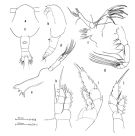 issued from : O. Tanaka & M. Omori in Publs Seto Mar. Biol. Lab., 1974, XXI (3/4). [p.259, Fig.30]. Female: a, forehead (dorsal); b, idem (lateral); c, last thoracic segment and urosome (dorsal); d, idem (lateral left side); e, Md; f, Mx1; g, Mxp; h, P1; i, P2; j, P5. Nota: The urosome segments and furca are in the proportional lengths as 51:14:15:20 = 100. Prosome and urosome are in the proportional lengths as 80:20. A1 extends beyond the end of the furca by 4 segments. The specimen has a structure more similar to Sars (1925) than to Sewell (1947).
|
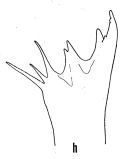 issued from : O. Tanaka & M. Omori in Publs Seto Mar. Biol. Lab., 1974, XXI (3/4). [p.199, Fig.2,h]. Female: h, mandibular teeth.
|
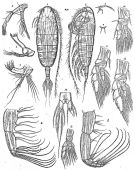 Issued from : G.O. Sars in Résult. Camp. Scient. Prince Albert I, 69, pls.1-127 (1924). [Pl.XCVII, figs.1-14]. Female: 1, habitus (dorsal); 2, idem (lateral left side); 3, forehead (lateral); 4, rostrum; 5, A2; 6, Md; 7, Mx1; 8, Mx2; 9, Mxp; 10, P1; 11, P2; 12, P3; 13, P5; 14, anal segment and caudal rami (dorsal).
|
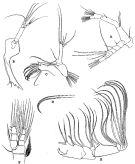 issued from : R.B.S. Sewell in The John Murray Expedition, 1933-34, Scientific Reports, VIII (1), 1947. [p.221, Fig.59]. As Euaugaptilus tenuispinus var. Female (fromN Arabian Sea): A, A2; B, Md; C, Mx1; D, one of the biting spines of inner lobe 1 (enlarged); E, Mx2; F, P1. Nota: The proportional lengths of the various segments of the body (cephalon to caudal rami) as 358:154:97:88:90:97:28:41:47 = 1000. A small cervical groove crosses the dorsal aspect of the cephalon. A row of fine hairs runs transversely just in front of the genital aperture situated about the middle of the segment. A1 25-segmented (1segments 1 and 2 patlly fused), over-reaches the caudal rami by about the last 3 segments. In A2 the endopod bears 6 setae on the outer lobe and 3 large and 4 small setae on the inner lobe; exopod 8-segmented. In Md the biting blade is strong, but the edge is considerably more oblique than figured by Sars, the arrangement of the teeth is , however, the same; endopod 2-segmented; exopod 5-segmented. In Mx1 the lobes bear the following setae: inner lobe 1 (11 setae, of which 7 are fringed with closely set \"buttons\"), inner lobe 2 (1 large seta), inner lobe 3 (1 small seta); segment basal 2 (2 setae instead 3 in Sars); exopod (4 setae on the outer margin and 2 large and 1 small distally); outer lobe (6 large and 3 small setae). In Mx2 bears the following setae: lobe 1 with 3 setae and a very short pointed process, lobe 2 (2), lobe 3 (2), lobe 4 (3), lobe 5 (2), lobe 6 (3); endopod with 7 setae. Most of the setae are fringed with \"buttons\".
|
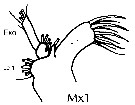 issued from : J.M. Bradford-Grieve, E.L. Markhaseva & C.E.F. Rocha & B. Abiahy in South Atlantic Zooplankton, Edit. D. Boltovskoy. 1999. Vol.2. Copepoda. [p.1041, Fig. 7.264]. Female: Mx1. Nota: inner lobe 4 with 3 setae; Endopod absent.
|
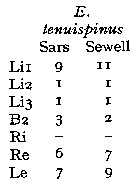 issued from : J.B.L. Matthews in Bull. Br. Mus. (Nat. Hist.) Zool., 1972, 24 (1). [p.25, Table 2]. Differences in setation of Mx1, according to previous descriptions.
| | | | | Compl. Ref.: | | | Sewell, 1948 (p.331, 505, 522, 527, 528, 533); Grice & Hulsemann, 1967 (p.19); Vives, 1982 (p.294); Lozano Soldevilla & al., 1988 (p.60); Matsuura & al., 2010 (p.2098, Table 3, fig.8) | | | | NZ: | 6 | | |
|
Distribution map of Euaugaptilus tenuispinus by geographical zones
|
| | | | | | | Loc: | | | G. of Guinea, Canary Is., Azores, W Gibraltar, Floridea, Caribbean, Arabian Sea, W Indian, Laccadive Is., Indonesia (Celebes Sea), Japan (Izu region) | | | | N: | 11 | | | | Lg.: | | | (1) F: 4,9; (11) F: 5,3; (16) F: 4,9-4,5; (68) F: 5,27; {F: 4,50-5,27} | | | | Rem.: | bathypelagic. Known to occur at a depth of 900 m (Matthews, 1972).
First occurrence in Indonesian waters by Matsuura & al. (2010).
In ''squamatus" Group after Matthews (1972, p.64) {See remarks in Euaugaptilus genus}. | | | Last update : 18/08/2018 | |
|
|
 Any use of this site for a publication will be mentioned with the following reference : Any use of this site for a publication will be mentioned with the following reference :
Razouls C., Desreumaux N., Kouwenberg J. and de Bovée F., 2005-2025. - Biodiversity of Marine Planktonic Copepods (morphology, geographical distribution and biological data). Sorbonne University, CNRS. Available at http://copepodes.obs-banyuls.fr/en [Accessed November 30, 2025] © copyright 2005-2025 Sorbonne University, CNRS
|
|
 |
 |









